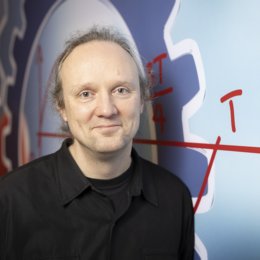Computational Mechanics of Multiscale Materials
My name is Harm Askes and I am a Professor of Computational Mechanics of Multiscale Materials in the Faculty of Engineering Technology.
Background
I hold MSc (1995) and PhD (2000) degrees from Delft University of Technology where I studied civil engineering and carried out research on numerical methods for failure analysis of engineering structures. I was an Assistant Professor in Delft 1999-2004.
I was appointed Professor of Computational Mechanics at the University of Sheffield, United Kingdom, in 2004. In Sheffield, I was also Head of the Department of Civil and Structural Engineering (2009-2017), Head of Interdisciplinary Programmes in Engineering (2017-2021) and Deputy Vice-President for Education (2021). Sheffield awarded me a higher doctorate DEng degree for my research in 2013 and I won several prizes for my teaching.
In January 2022 I moved to the University of Twente to take up my current position.
In the years to come
I am fascinated by how materials and structures react to extreme loading – especially extremely fast loading. There is often a human aspect to this mechanical response, in that people need to be protected from uncomfortable vibrations, unwanted noise, or life-threatening vehicle impact, e.g. Designing a material, such that it possesses optimal behaviour at the macroscale means, we have to understand the behaviour of its microstructural components – and particularly the interactions between these components.
This is where multiscale modelling comes in. By developing material models and computer simulations, we are able to understand how microscale mechanical behaviour drives macroscale mechanical behaviour – and vice versa. Once we understand this multiscale interaction, we are able to control it and optimise it.
Ongoing work is concentrated on the crossover with advanced manufacturing and the extension from purely mechanical behaviour to coupled physics, such as piezomagnetic and piezoelectric behaviour.
Education
I thoroughly enjoy teaching fundamental mechanics courses such as Statics, Dynamics, and Strength of Materials, but I have also taught advanced courses on Finite Element theory and applications. Because different people learn in different ways, my lectures are a mix of top-down “deduction” (use first principles to establish practical approaches to calculation) and bottom-up “induction” (establish patterns through the systematic study of particular cases).
Whether I teach 30 or 300 students, I make sure I have a good understanding with the students so that questions are encouraged. I have won various prizes and accolades, acknowledging both the quality of my classroom teaching and my leadership as Head of Department.
Collaborations
As a computer modeller, I am always keen to explore new avenues of research. I have worked with mathematicians, physicists, material scientists and engineers, both from academia and industry – and I have learned a lot from them all. The creative tension that exists in cross-disciplinary environments is invaluable for progress.

